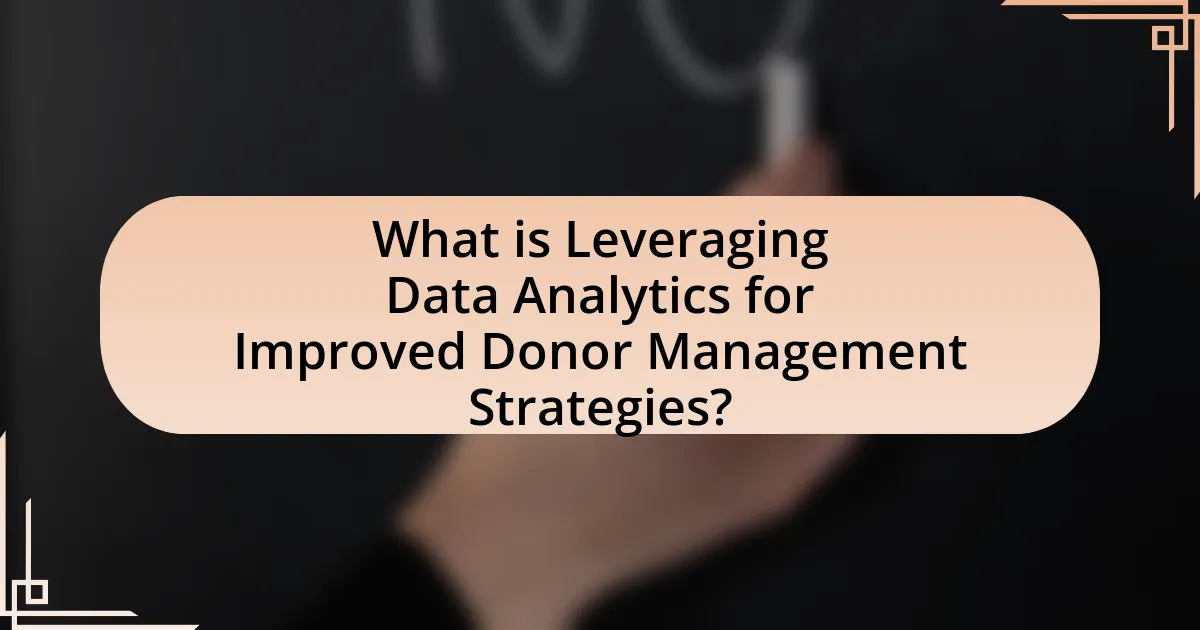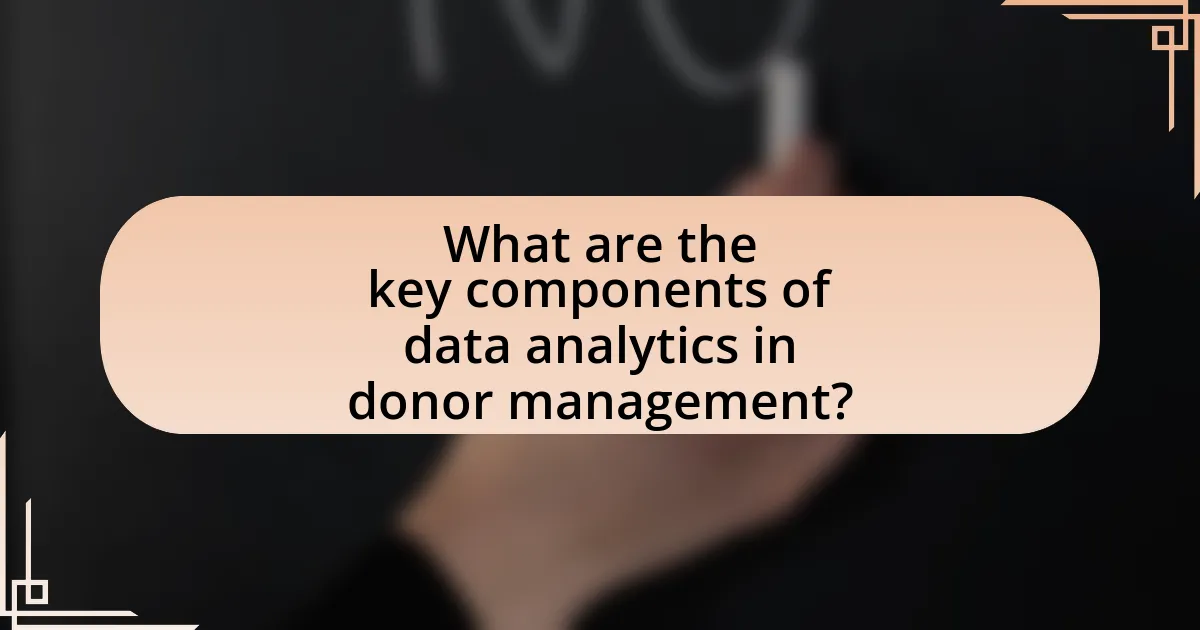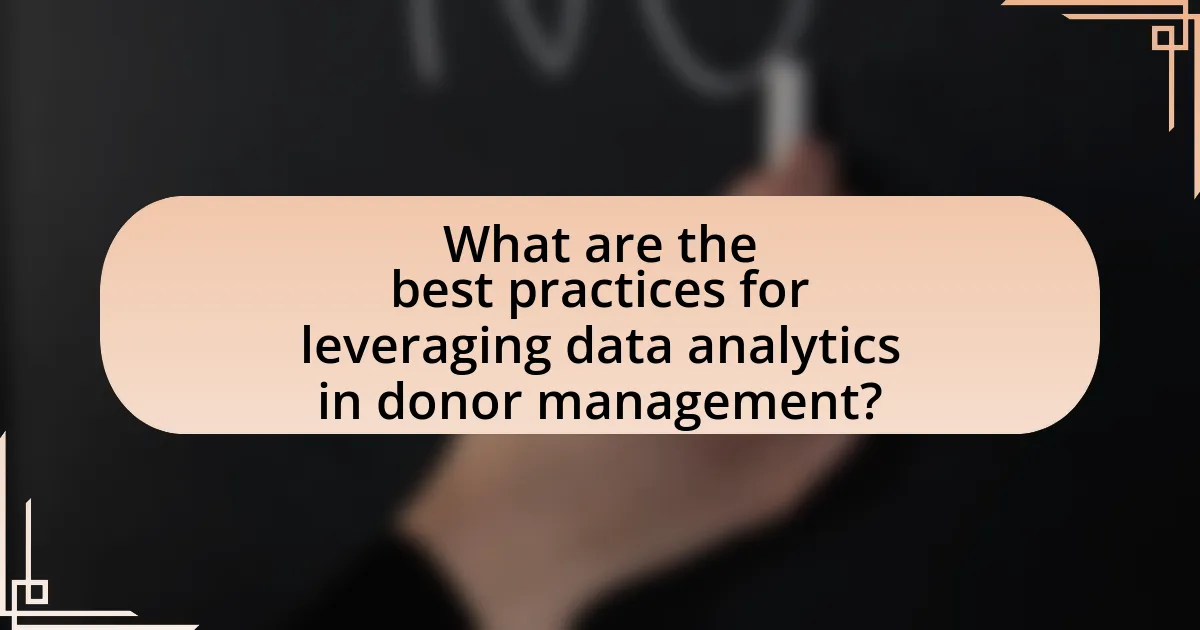Leveraging data analytics for improved donor management strategies is essential for organizations seeking to enhance fundraising effectiveness and strengthen donor relationships. The article explores how data-driven insights can inform communication and outreach strategies, leading to increased donor retention and contributions. It discusses specific data analytics techniques such as predictive analytics, segmentation analysis, and data visualization, highlighting their role in personalizing donor engagement. Additionally, the article addresses the importance of data quality, common challenges organizations face, and best practices for implementing data analytics to optimize donor management and fundraising outcomes.
What is Leveraging Data Analytics for Improved Donor Management Strategies?

Leveraging data analytics for improved donor management strategies involves utilizing data-driven insights to enhance the effectiveness of fundraising efforts and donor relationships. Organizations can analyze donor behavior, preferences, and engagement patterns to tailor communication and outreach strategies, ultimately increasing donor retention and contributions. For instance, a study by the Association of Fundraising Professionals found that organizations using data analytics saw a 20% increase in donor retention rates. This demonstrates that informed decision-making based on data analytics can significantly improve donor management outcomes.
How does data analytics enhance donor management?
Data analytics enhances donor management by providing insights into donor behavior and preferences, enabling organizations to tailor their engagement strategies effectively. By analyzing historical donation data, organizations can identify trends, segment donors based on giving patterns, and predict future contributions. For instance, a study by the Association of Fundraising Professionals found that organizations using data analytics saw a 20% increase in donor retention rates. This demonstrates that leveraging data analytics not only improves understanding of donor motivations but also leads to more personalized communication, ultimately fostering stronger relationships and increasing overall fundraising success.
What specific data analytics techniques are used in donor management?
Specific data analytics techniques used in donor management include predictive analytics, segmentation analysis, and data visualization. Predictive analytics helps organizations forecast donor behavior and potential contributions by analyzing historical data patterns. Segmentation analysis categorizes donors based on demographics, giving history, and engagement levels, allowing for targeted communication strategies. Data visualization techniques, such as dashboards and charts, present complex data in an easily interpretable format, facilitating informed decision-making. These techniques collectively enhance donor engagement and retention by providing actionable insights.
How do these techniques improve donor engagement?
Data analytics techniques improve donor engagement by enabling organizations to personalize communication and tailor fundraising strategies based on donor behavior and preferences. By analyzing historical donation patterns, organizations can identify trends and segment donors, allowing for targeted outreach that resonates with individual motivations. For instance, a study by the Association of Fundraising Professionals found that personalized communication can increase donor retention rates by up to 20%. This targeted approach not only enhances the donor experience but also fosters a stronger emotional connection, ultimately leading to increased loyalty and higher donation amounts.
Why is donor management important for organizations?
Donor management is crucial for organizations because it enhances fundraising efficiency and fosters long-term relationships with supporters. Effective donor management systems allow organizations to track contributions, understand donor preferences, and tailor communication strategies, which can lead to increased donor retention rates. Research indicates that organizations with robust donor management practices can see up to a 30% increase in repeat donations, demonstrating the tangible benefits of maintaining strong donor relationships.
What challenges do organizations face in donor management?
Organizations face several challenges in donor management, including data integration, donor engagement, and retention. Data integration issues arise when organizations struggle to consolidate information from various sources, leading to incomplete donor profiles and ineffective communication strategies. Additionally, maintaining donor engagement is challenging as organizations must continuously provide value and connection to their supporters, which can be resource-intensive. Retention of donors is another significant challenge, with studies indicating that nearly 60% of first-time donors do not give again, highlighting the need for effective follow-up and relationship-building strategies. These challenges underscore the importance of leveraging data analytics to enhance donor management practices and improve overall fundraising outcomes.
How can effective donor management impact fundraising efforts?
Effective donor management significantly enhances fundraising efforts by fostering stronger relationships with donors, leading to increased contributions. When organizations implement effective donor management strategies, they can personalize communication, track donor preferences, and engage supporters more meaningfully. Research indicates that organizations utilizing data analytics for donor management see a 20% increase in donor retention rates, which directly correlates with higher overall fundraising outcomes. By understanding donor behavior and preferences through data, organizations can tailor their approaches, resulting in more successful fundraising campaigns.
What are the key components of data analytics in donor management?

The key components of data analytics in donor management include data collection, data processing, data analysis, and data visualization. Data collection involves gathering information from various sources such as donor databases, surveys, and social media interactions. Data processing refers to cleaning and organizing this data to ensure accuracy and usability. Data analysis encompasses applying statistical methods and algorithms to identify trends, donor behaviors, and segmentation opportunities. Finally, data visualization presents the analyzed data in an easily interpretable format, such as charts and graphs, facilitating informed decision-making. These components collectively enhance donor engagement and optimize fundraising strategies.
What types of data are most valuable for donor management?
The most valuable types of data for donor management include donor demographics, giving history, engagement metrics, and communication preferences. Donor demographics provide insights into the background and interests of donors, which can inform targeted outreach strategies. Giving history reveals patterns in donation amounts and frequency, allowing organizations to identify major donors and predict future giving behavior. Engagement metrics, such as event attendance and volunteer participation, help assess donor involvement and loyalty. Lastly, understanding communication preferences ensures that organizations can tailor their messaging effectively, enhancing donor relationships and retention.
How can demographic data influence donor strategies?
Demographic data can significantly influence donor strategies by enabling organizations to tailor their outreach and engagement efforts based on specific characteristics of their donor base. For instance, understanding age, income level, and geographic location allows organizations to segment their donors and create targeted campaigns that resonate with each group’s preferences and motivations. Research indicates that targeted messaging can increase donor engagement by up to 50%, demonstrating the effectiveness of using demographic insights to refine strategies. By analyzing demographic trends, organizations can also identify potential new donor segments, optimizing fundraising efforts and improving overall donor retention rates.
What role does transaction history play in understanding donor behavior?
Transaction history is crucial for understanding donor behavior as it provides insights into giving patterns, preferences, and engagement levels. Analyzing transaction history allows organizations to identify trends such as frequency of donations, average donation amounts, and preferred causes, which can inform targeted fundraising strategies. For instance, a study by the Association of Fundraising Professionals found that organizations leveraging transaction data saw a 20% increase in donor retention rates. This demonstrates that transaction history not only reveals individual donor motivations but also enhances overall donor management strategies by enabling personalized communication and tailored engagement efforts.
How can organizations implement data analytics for donor management?
Organizations can implement data analytics for donor management by integrating advanced analytics tools to analyze donor behavior and preferences. This involves collecting data from various sources such as donation history, engagement metrics, and demographic information. By utilizing predictive analytics, organizations can identify potential major donors and tailor their outreach strategies accordingly. For instance, a study by the Association of Fundraising Professionals found that organizations using data analytics saw a 20% increase in donor retention rates. This demonstrates that effective data analytics not only enhances understanding of donor motivations but also improves overall fundraising outcomes.
What tools and software are available for data analytics in this context?
Tools and software available for data analytics in the context of improved donor management strategies include Tableau, Microsoft Power BI, and Google Analytics. Tableau enables users to visualize data and create interactive dashboards, facilitating insights into donor behavior and trends. Microsoft Power BI offers robust data modeling and reporting capabilities, allowing organizations to analyze donor data effectively. Google Analytics provides web analytics services that help track donor engagement and optimize online fundraising efforts. These tools are widely recognized for their effectiveness in enhancing data-driven decision-making in donor management.
How can organizations train staff to utilize data analytics effectively?
Organizations can train staff to utilize data analytics effectively by implementing structured training programs that focus on practical applications of data analysis tools and techniques. These programs should include hands-on workshops, online courses, and real-world case studies that demonstrate the impact of data analytics on donor management strategies. For instance, a study by McKinsey & Company found that organizations that invest in data analytics training see a 20% increase in employee productivity and a 15% improvement in decision-making quality. By providing access to relevant software and encouraging collaborative projects, organizations can enhance staff proficiency in data analytics, ultimately leading to better donor engagement and retention.
What are the best practices for leveraging data analytics in donor management?

The best practices for leveraging data analytics in donor management include segmenting donor data, utilizing predictive analytics, and measuring engagement metrics. Segmenting donor data allows organizations to tailor communication and fundraising strategies to specific donor groups, enhancing engagement and retention. Utilizing predictive analytics helps forecast donor behavior and identify potential major gifts, enabling proactive outreach. Measuring engagement metrics, such as donation frequency and response rates, provides insights into donor preferences and effectiveness of campaigns, allowing for continuous improvement. These practices are supported by studies indicating that organizations employing data analytics see a 20% increase in donor retention rates and a 15% increase in overall fundraising effectiveness.
How can organizations ensure data quality and accuracy?
Organizations can ensure data quality and accuracy by implementing robust data governance frameworks. These frameworks establish clear policies and procedures for data collection, validation, and maintenance, which are essential for maintaining high-quality data. For instance, regular audits and data cleansing processes can identify and rectify inaccuracies, ensuring that the data remains reliable over time. Additionally, training staff on data management best practices enhances awareness and adherence to quality standards. Research indicates that organizations with strong data governance see a 30% improvement in data accuracy, as reported by the Data Governance Institute.
What processes should be in place for data collection and analysis?
Effective data collection and analysis processes should include systematic data gathering, data cleaning, data integration, and data analysis methodologies. Systematic data gathering involves defining clear objectives and utilizing various methods such as surveys, interviews, and automated data collection tools to ensure comprehensive data acquisition. Data cleaning is essential to remove inaccuracies and inconsistencies, which can be achieved through validation techniques and automated scripts. Data integration combines data from multiple sources, ensuring a unified dataset for analysis, often facilitated by data warehousing solutions. Finally, employing statistical and analytical methods, such as regression analysis or machine learning algorithms, allows organizations to derive actionable insights from the data. These processes are validated by industry standards, such as the Data Management Body of Knowledge (DMBOK), which emphasizes the importance of structured data management practices for effective decision-making.
How can organizations regularly update and maintain their donor databases?
Organizations can regularly update and maintain their donor databases by implementing automated data entry systems and conducting periodic data audits. Automated systems reduce human error and ensure real-time updates, while regular audits help identify outdated or incorrect information. According to a study by the Data Management Association, organizations that utilize automated data management tools experience a 30% increase in data accuracy. Additionally, integrating data analytics tools allows organizations to analyze donor behavior and preferences, facilitating targeted communication and engagement strategies that keep donor information current and relevant.
What common pitfalls should organizations avoid when using data analytics?
Organizations should avoid common pitfalls such as neglecting data quality, failing to define clear objectives, and overlooking user training when using data analytics. Neglecting data quality can lead to inaccurate insights, as studies show that poor data quality costs organizations an average of $15 million annually. Failing to define clear objectives results in wasted resources and misaligned efforts, as analytics initiatives without specific goals often yield irrelevant results. Additionally, overlooking user training can hinder the effective use of analytics tools, as research indicates that 70% of analytics projects fail due to lack of user adoption and understanding.
How can over-reliance on data analytics negatively impact donor relationships?
Over-reliance on data analytics can negatively impact donor relationships by creating a disconnect between organizations and their donors. When organizations prioritize data-driven insights over personal interactions, they may fail to understand the emotional and relational aspects that motivate donors. This detachment can lead to a perception that donors are merely data points rather than valued partners, resulting in decreased donor engagement and loyalty. Research indicates that 70% of donors prefer personalized communication, which can be overlooked when organizations focus solely on analytics.
What are the risks of misinterpreting data analytics results?
Misinterpreting data analytics results can lead to poor decision-making, which may negatively impact donor management strategies. For instance, incorrect conclusions drawn from data can result in misallocation of resources, ultimately diminishing donor engagement and retention. A study by the Harvard Business Review highlights that organizations relying on flawed data interpretations can experience a 20% decrease in operational efficiency. Additionally, misinterpretation can foster mistrust among stakeholders, as decisions based on inaccurate data may not align with actual donor behavior or preferences. This misalignment can further exacerbate the challenges in building effective donor relationships and achieving strategic goals.
What practical tips can organizations follow to enhance donor management through data analytics?
Organizations can enhance donor management through data analytics by implementing targeted segmentation of donor data. This approach allows organizations to categorize donors based on giving history, engagement levels, and demographics, enabling personalized communication strategies that resonate with each segment. For instance, a study by the Association of Fundraising Professionals found that targeted messaging can increase donor retention rates by up to 30%.
Additionally, organizations should utilize predictive analytics to forecast donor behavior and identify potential major gift prospects. By analyzing historical donation patterns and external factors, organizations can prioritize outreach efforts effectively. Research from Blackbaud indicates that organizations using predictive analytics see a 20% increase in fundraising efficiency.
Finally, organizations must regularly evaluate and refine their data collection methods to ensure accuracy and relevance. Implementing robust data management systems can lead to improved data quality, which is essential for making informed decisions. According to a report by the Data Management Association, organizations that prioritize data quality experience a 15% increase in overall fundraising performance.